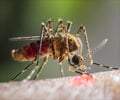The Californian health authorities are perturbed by the sharp rise of the west nile virus cases among humans much earlier than expected. The mosquito borne illness continues to climb throughout the state despite an oppressive drought this year.
There were 18 new human cases of West Nile virus reported this week by the California Department of Public Health, double the number counted since the first case of the year was confirmed on June 20. That brings the state total to 27, and puts the California count slightly ahead of 2005, when the virus sickened 935 and killed 19. Last year, there were only 292 cases statewide and seven deaths.There have been 64 more dead birds and 76 more mosquito samples this year that have tested positive for the virus than in 2006, state records show.
Mosquitoes are the main transmitters for the virus, which can cause fever, headache, tremors and other neurological afflictions, according to the U.S. Centers for Disease Control and Prevention.
Although mosquitoes flourish when heavy rains leave tracts of standing water, the current drought may be accelerating the disease because it is crowding birds into smaller watering holes where they are more likely to come in contact with mosquitoes. Birds are the primary reservoir for West Nile virus, and the mosquitoes who feed on them transmit it from bird to human. The drought is also reducing the natural flushing of urban storm drains, causing stagnant puddles that are ideal breeding grounds for Culex quinquefasciatus, a variety of mosquito linked to many West Nile outbreaks.
During the dry spell the citizens too unknowingly add to the problem- like over watering the lawns send run-off into storm drains which is a popular breeding site for mosquitoes.
The vector control district hires crews specifically assigned to mitigating that problem, but stagnant water created on private property is the hardest to scope out.
Advertisement
This year, West Nile virus has been responsible for one fatality in California. Marguerite Wilson, a 96-year-old Bakersfield woman, died July 11 of encephalitis brought on by the virus.
Advertisement
Risk for contraction is equally spread throughout the county since mosquitoes can only travel between one and seven miles from where they emerge from larvae as adults, Thus leading the Vector control officials to ask the public to alter their water use.
Source-Medindia
BIN/C









